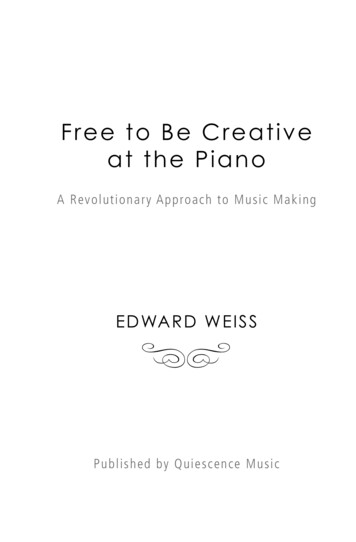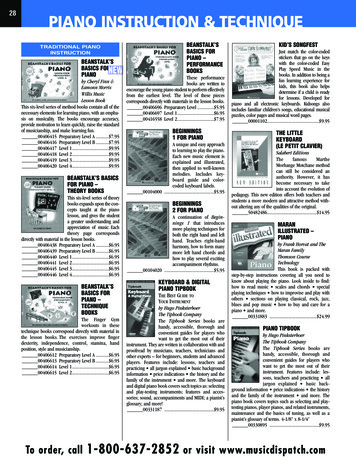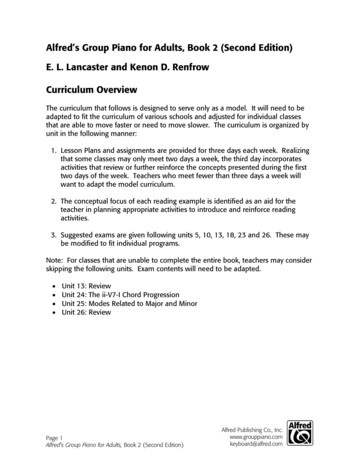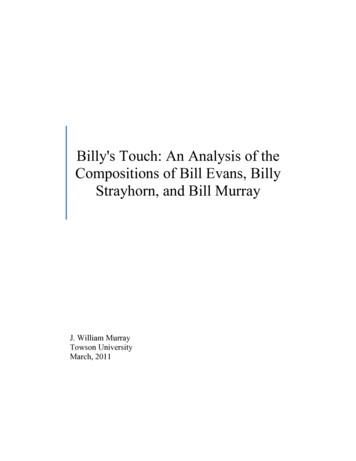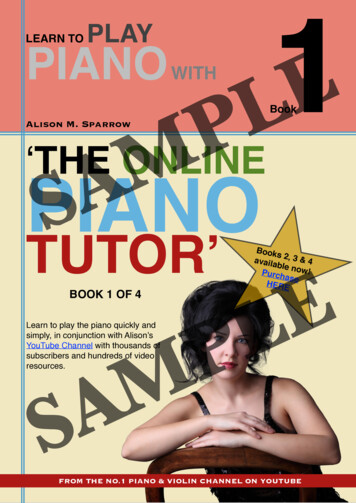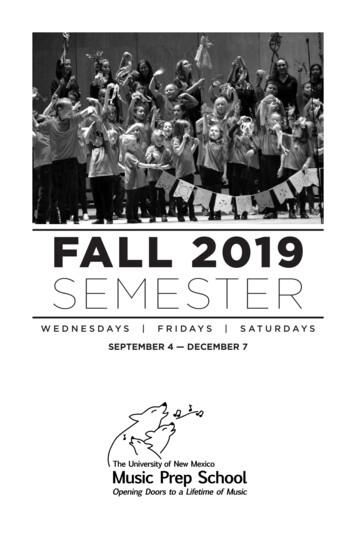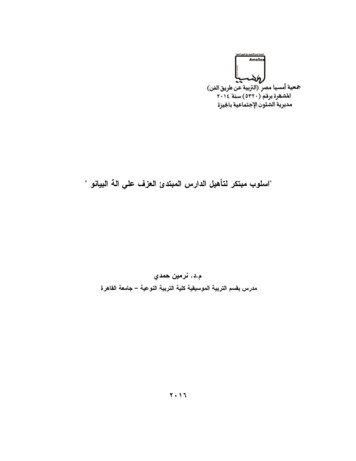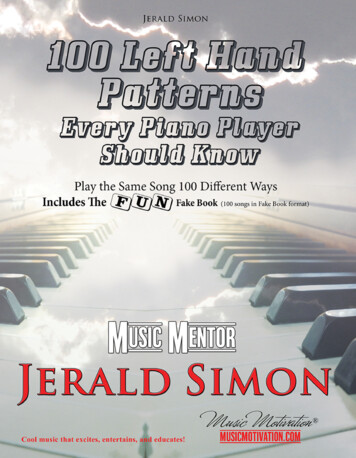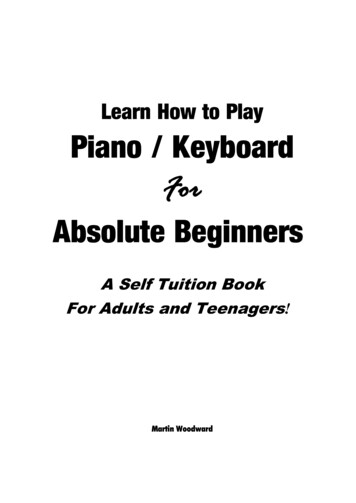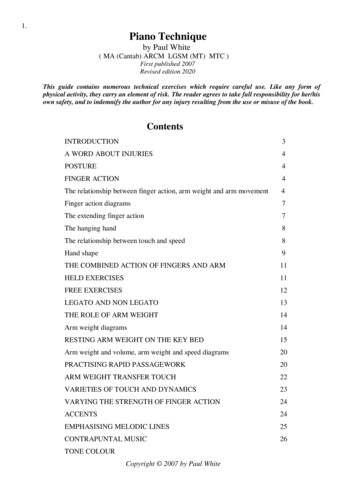
Transcription
1.Piano Techniqueby Paul White( MA (Cantab) ARCM LGSM (MT) MTC )First published 2007Revised edition 2020This guide contains numerous technical exercises which require careful use. Like any form ofphysical activity, they carry an element of risk. The reader agrees to take full responsibility for her/hisown safety, and to indemnify the author for any injury resulting from the use or misuse of the book.ContentsINTRODUCTION3A WORD ABOUT INJURIES4POSTURE4FINGER ACTION4The relationship between finger action, arm weight and arm movement4Finger action diagrams7The extending finger action7The hanging hand8The relationship between touch and speed8Hand shape9THE COMBINED ACTION OF FINGERS AND ARM11HELD EXERCISES11FREE EXERCISES12LEGATO AND NON LEGATO13THE ROLE OF ARM WEIGHT14Arm weight diagrams14RESTING ARM WEIGHT ON THE KEY BED15Arm weight and volume, arm weight and speed diagrams20PRACTISING RAPID PASSAGEWORK20ARM WEIGHT TRANSFER TOUCH22VARIETIES OF TOUCH AND DYNAMICS23VARYING THE STRENGTH OF FINGER ACTION24ACCENTS24EMPHASISING MELODIC LINES25CONTRAPUNTAL MUSIC26TONE COLOURCopyright 2007 by Paul White
2.STACCATO27Staccato with wing action28Staccato with wing action diagrams28Prepared staccato notes and chords with wing action digrams29Finger staccato29Wrist staccato octaves31TOUCH CHANGES RELATED TO SPEED32TECHNIQUE AND EXPRESSION33WING ACTION FOR CHORDS AND OCTAVES33Wing action diagrams35WRIST MOVEMENT IN PHRASING35SOME SPECIAL TECHNIQUES WITH CHORDS AND OCTAVES36Preparing hand shape in chords and melodies36Gliding chords37Rapid pairs of chords37Weighing the notes of a chord38ACTION OF THE BACK38THE MECHANICS OF TONE PRODUCTION38Controlling articulation41THERAPEUTIC EXERCISES41Finger-stretching exercises43UNINTENTIONAL COMPLIMENTARY ARM MOVEMENTS47Forearm rotation47Other unintentional arm movements48PRACTICE METHODS48General points48Starting slowly and speeding up49Memorization and mental practice51Musical Attention52Special techniques for difficult sections53FINGERING: SOME GENERAL POINTS55THE PEDALS56ANALYSIS57CULTIVATING A NATURAL TECHNIQUE57BIBLIOGRAPHY59TECHNICAL EXERCISES60
3.IntroductionThis guide aims to be clear, concise and practical. It draws on a number of well-known sources (see page59), but, above all, it is the result of several decades of observation and experiment. Standard aspects oftechnique are discussed, but special emphasis is given to areas, where, it is hoped, some new light is shedupon either the technique itself or the way of explaining it. A selection of exercises mentioned in the text canbe found at the end of the guide. Further exercises can be found online via this te743In any project, the initial design is of critical importance. Years of dedication and hard work are often wastedon flawed designs, for example, on civil engineering projects which collapse soon after completion. In thecase of piano playing, countless thousands of talented and hard-working students have failed torealize their potential due to faulty technical instruction. A correct understanding of the basic principles oftechnique affects every single note we play, so that each moment of our practice will be put to optimumeffect. One result of the preponderance of poor technical teaching which took place in the twentieth centuryis that many people have abandoned technique, considering it to be a waste of time. To these people I wouldreply that having no technique is better than having a bad one, but having a good one is the by far the bestoption. It is sometimes said that, if we focus entirely on the musical aim, the technical details willautomatically fall into line. This has some validity, especially for talented people who have a natural aptitudefor doing things in the right way, but it can also lead to very inappropriate solutions, just as when amateursingers seek to impress their audience by shouting, but fail to come anywhere near the power and beauty oftone achieved by the opera singer. Similarly, the untrained pianist may strive for brilliance in passageworkby means of repeated downward strokes of the arm, or by pressing forward into the keys.Of the many schools of piano technique which have existed during the last century, the most influential havebeen the “arm weight” and “raised finger” schools. The first of these has tended to use a maximum amountof arm weight whilst virually ignoring finger movement, whilst the second has done exactly the reverse. Thecentral theme of this guide is that musical tone consists of an inseperable combination of both of theseelements, and that we should not only be able to use each to the maximum extent but also to use them in acontrolled way, so that the amount of arm weight and finger speed, and the proportions of each, can bevaried at will. Only by doing this can we achieve variety of dynamics and touch, and the ability to emphasizedifferent voices in a musical texture.Teachers often tell people what musical result to aim for, but not how to achieve it or why we would do it inthat way. This book attempts to fill in those gaps. Neverthless, in studying the technical principles, weshould never lose sight of the artistic aim, as this is the whole point of the exercise. Above all, unless themusic demands otherwise, we should always aim to achieve a singing tone in our playing. This will help usintuitively to combine the various aspects of technique and guide them towards the creation of a trulybeautiful performance.The greatest physique in the world is of no use without a brain attached to it. A fundamental aspect ofplaying which is often overlooked is that we always hear the music in our head before we play it. Even insight-reading, we see the score, hear the music in our “inner ear” and translate what we hear into fingermovements at the keyboard. Developing the inner ear is therefore an indispensable element in pianotechnique. This can be achieved through aural training, musical dictation and “mental practice” (see p. 50).Many hours are wasted at the piano by adopting an attitude of blind faith and mindless drudgery. We shouldinstead take an analytical and diagnostic approach, identifying and focusing on core issues rather than takingevery technical problem in isolation. To take just one example, many problems of evenness are caused byweakness in the outer fingers. Honing in further, a particular weakness is the alternation of fingers 4 and 2together with 5 and 3 together. Still closer investigation reveals that the alternation is more difficult from 4/2to 5/3 than the other way round. Other difficult moves include from 3 to 4 and from 4 to 5, where we aremoving from a stronger, longer finger to a shorter, weaker one. These moves can be practised as grace notesor using Exercises 9 and 10E at the end of this guide. In this case, by tackling the root cause, we will solve awide proliferation of problems concerning evenness. This differs from the approach of teachers who believein dealing with technical matters only as and when they arise in the course of learning pieces, although
4.that is also an important element in technical training.A word about injuriesCompared with some “relaxation methods”, the approach recommended here is quite a vigorous one. Itshould be used in a sensible and moderate way, especially to begin with. It is a dangerous mistake tosuppose that a method which yields good results will yield even better ones when taken to extremes. Ipersonally have been playing the piano for fifty-seven years and have never suffered an injury, nor, to thebest of my knowledge, have I ever caused anyone else to have one. Even so, one cannot be too careful!A number of manual activities undertaken by most people on an everyday basis, including housework andgardening, many lead to stiffness in the hands. The index finger of our dominant hand is sometimes requiredto exert pressure for long periods, for example when using aerosols and spray guns. A similar case iswriter’s cramp, common among students at school or university. This is fortunately diminishing thanks tothe increasing use of computer technology, only to be replaced by misuse of the thumbs on mobile devices.Such problems can often be remedied by means of stretching exercises related to Yoga, several of which areexplained in the chapter on therapeutic exercises (p.41).Excessively strenuous practice may cause some people to experience difficulty in bending their fingers whenthey first wake in the morning. In this case, do not use force to bend the fingers, but gently coax them into arounded position using the other hand. At the same time reduce the arm weight and finger action inpractising until the problem disappears. Injuries are caused not only by an extreme approach to lifting thefingers, but also by requiring them to bear too much weight.In recent times, an almost paranoid aversion to injuries has given rise to varous technical methods which aregeared more towards protecting the fingers than towards achieving a convincing musical performance. Inparticular, finger exercises are described as “dangerous”. I would propose the contrary argument, namelythat the development of strong finger muscles is not only necessary in achieving effective musical results,but is also the best way of guarding against injury, provided it is done in a gradual and moderate way. Thereis an element of compromise between achieving the best musical result and being kind to the hands. Amusician of integrity will always place the artistic aim first.PostureFreedom of movement is our aim, not restriction and rigidity. This applies firstly to the process of breathing,which can sometimes inadvertently come to a halt when we are intent upon a demanding task. Of equalimportance is the way we sit, which should be tall but not stiff, with the shoulders relaxed and down, yetwith a certain feeling of buoyancy. Some slow, gentle rocking back, forth and sideways from the hips keepsthe joints of the arm mobile. Posture and seating position affect the way in which arm weight operates. If wesit too close to the piano or lean forward, as sometimes happens when sight-reading, the arms will push thehands forwards, jamming the wrists and forcing the fingers to play from an awkward angle. Moving back alittle and returning the trunk to a vertical position will cause the arms to pull the hands gently backwards,restoring them to a healthy playing position. If we imagine arm weight to be operating vertically on the keys,this will in fact cause the arms to straighten and push forwards, creating the same problems as mentionedabove. We should think of the elbows as wanting to bend and pull backwards, the wrists as being drawndownwards and the fingers as pulling at the keys.Finger ActionThe relationship between finger action, arm weight and arm movementMusic is brought to life by means of contrast and variety. Just as the owner of a powerful sports car is able(though not necessarily willing) to drive both slowly and fast, so the pianist with a strong technique can playmusic which is both quiet and loud, slow and fast. Anyone watching a virtuoso performance of one of thegreat Romantic works, for example, will realize that, at the more passionate end of the expressive spectrum,this can be a very high impact activity. Weak pianists can only produce quiet tones, resulting in a dull,monochrome effect, and will be unable to play clearly at speed (see p.21). They will also have difficulty in
5.emphasizing particular voices in a texture, for example bringing out a melodic line. Therefore in our practicewe aim to build strength, both in the muscle tissue itself and in the power of the neuro-muscular impulse.These two form an inseparable combination. To this end, given that the body gradually adapts to demandsplaced upon it, the way to build strong fingers is by requiring them to transmit the maximum of kineticenergy to the keys (see p.38). The initial paragraphs which follow refer to practising finger work intechnical exercises, scales and passagework, not to the performance of quiet passages, and not to the playingof chords and octaves.The greatest piano teacher ever was Sir Isaac Newton, although he did not know it. The observations whichfollow are all based on simple Newtonian mechanics. They may sound very complicated compared with thefacile solutions offered by many traditional schools, but provide the only valid description of what reallyhappens when we play.The force needed to move an object (in this case a piano key) is kinetic energy, which is a combination ofweight and speed, as stated in the equation KE (kinetic energy) ½ mv2 (where m mass and v velocity).The weight is provided by resting some of the arm’s weight on the keys. This is initially introducedby “dropping” the arm’s weight on to the first note of a phrase or passage (p.34). Many existing methodsdeal with the initial dropping, but fail to describe adequately how the remaining notes in the phrase orpassage are played, i.e. the vast majority of the notes. These are produced in an entirely different manner.For these ensuing notes, when the fingertip strikes the key, the knuckle pushes upwards with equal force andreacts against the arm weight resting on the previous key. This causes the arm weight to react backdownwards upon the finger with an impulse of kinetic energy which will depend on the amount of weightwhich was resting and the speed of the finger stroke. It does not imply a downward movement by the arm(except on the first note.) It is like saying, “When we push against a wall, the wall pushes us the other way.”Similarly, if I wish to push a trolley, my arms push both forwards against the trolley and backwards at theshoulders against the weight of my body, which in turn reacts forward against the arms. It is by this processof opposite reactions that I apply my weight to the trolley. In the same way, in the case of the cyclist, the legextends, pushing down upon the
sit too close to the piano or lean forward, as sometimes happens when sight-reading, the arms will push the hands forwards, jamming the wrists and forcing the fingers to play from an awkward angle. Moving back a little and returning the trunk to a vertical position will cause the arms to pull the hands gently backwards,
